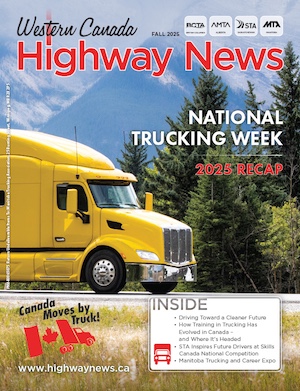Deborah Fonseca, Marketing and Communications Coordinator – AMTA
If you’ve ever been sitting in your car on the side of the road, engine failing, or vehicles speeding by, one of your first calls will be to a tow truck operator.
Tow truck operators hold crucial positions in Alberta. They get the most face-to-face time with the motoring public simply through day-to-day tasks, and they do it with a smile. Think about a high-stress situation. How did you get over that? Who did you lean on? What did they say to make you feel better? Operators ask themselves these questions before they step onto the road and assist the public. They know the importance of keeping their cool to make motorists feel safer, and they understand the intensity of emotions drivers might be going through.
“You can train someone to be an operator, but you can’t train them to be good people,” said Tyler Reed, Operations Manager, ATR Logistics, who was interviewed with ATR Logistics Office Manager Andrea Allegretto.
“98% of calls are not because they chose to call,” added Reed. Hence, the importance of having qualified, understanding operators on the team. Not only are operators tasked with transporting vehicles to a mechanic, but they are also there to personally guide motorists to safety.
Corey Hebel, General Manager, Oil Country Towing, similarly said it is about having a people person with the right attitude on the team; a positive outlook and expertise will always create a much greater impact on the client.
According to Reed, Allegretto, and Hebel, comprehensive training and safety procedures are the best way to instill the proper techniques for tow truck operators to tend to the motoring public’s needs. Apart from safety training, operators are provided with PPE, safety vests for visibility, road barriers, and amber and blue lights as preventative measures for potential incidents.
The addition of blue lights to tow trucks stemmed from a pilot project conducted in Alberta in 2022. Following the pilot in 2023, it was announced tow trucks and other vehicles, such as snowplows, could use the lights to increase visibility and driver safety for a further five years.
Training and Technology
Reed highlighted the importance of a tow truck crew with diverse experience and specialties, allowing for more efficient handling of specialty vehicles, commercial vehicles, and regular four-wheelers. Training procedures provide operators with the resources to identify roadside problems and use critical thinking to determine which approach will best handle the situation, ensuring every passenger’s safety is a top priority.
Technological advancements have propelled safety training and practices in the day-to-day. Hebel pointed out that as a result of driver education, Oil Country Towing has received fewer calls in recent years than in the past. Similarly, Reed shared that technology has significantly enhanced operator abilities, such as AI technologies that help operators track their driving patterns, satellite phones for remote areas, and FaceTime for helping colleagues.
A key factor of this industry is recognizing advancements and analyzing how they can play into the progression of one’s company standards. Within this sector of the commercial driving industry, towing companies “compete but are not competitive,” as Hebel put it, because they all work towards a common goal. As operators cooperate with each other, it is also important for the motoring public to be attentive, proactive, and cooperative in turn.
When it comes to the responsibility of motorists, the first consideration is following the law. In Alberta, when passing a commercial vehicle with amber and blue lights flashing, the legal speed is 60 km/h in the lane directly beside the vehicle.
Being stranded on the side of the road can be stressful for all, and in the words of Allegretto, “pack your patience.” Take the time to understand a situation, ask questions, and don’t rush into a solution.
The greatest takeaway is to appreciate tow truck operators for taking care of the public during times of need. It is also the motoring public’s duty to create a safe space for tow trucks to operate and fulfill their duties to get people back on the road.


 1-866-985-9791
1-866-985-9791



